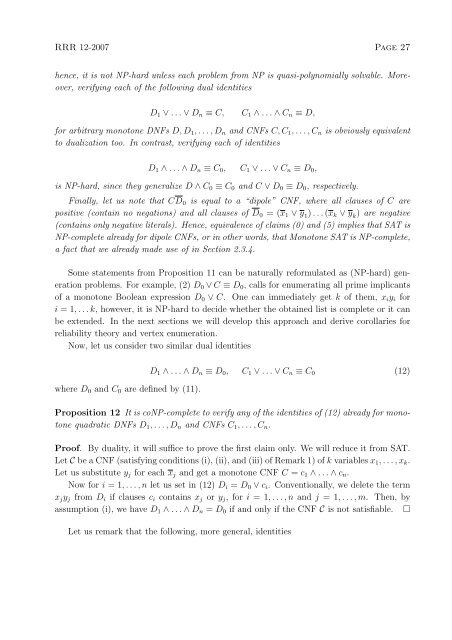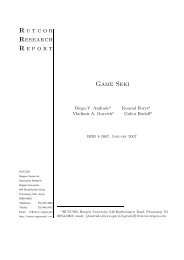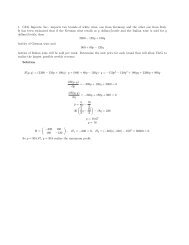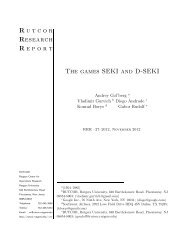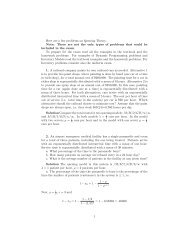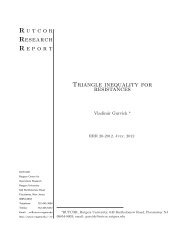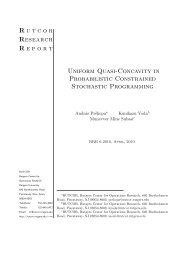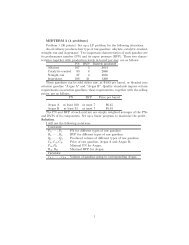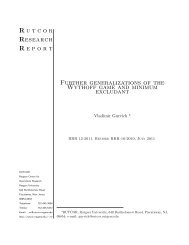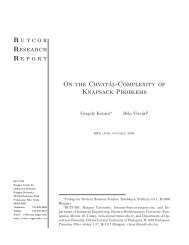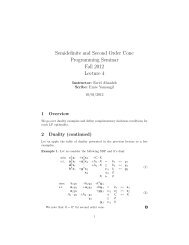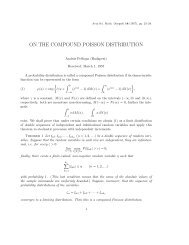Generating vertices of polyhedra and related monotone ... - Rutcor
Generating vertices of polyhedra and related monotone ... - Rutcor
Generating vertices of polyhedra and related monotone ... - Rutcor
Create successful ePaper yourself
Turn your PDF publications into a flip-book with our unique Google optimized e-Paper software.
RRR 12-2007 Page 27hence, it is not NP-hard unless each problem from NP is quasi-polynomially solvable. Moreover,verifying each <strong>of</strong> the following dual identitiesD 1 ∨ ... ∨ D n ≡ C, C 1 ∧ ... ∧ C n ≡ D,for arbitrary <strong>monotone</strong> DNFs D,D 1 ,...,D n <strong>and</strong> CNFs C,C 1 ,...,C n is obviously equivalentto dualization too. In contrast, verifying each <strong>of</strong> identitiesD 1 ∧ ... ∧ D n ≡ C 0 , C 1 ∨ ... ∨ C n ≡ D 0 ,is NP-hard, since they generalize D ∧ C 0 ≡ C 0 <strong>and</strong> C ∨ D 0 ≡ D 0 , respectively.Finally, let us note that CD 0 is equal to a “dipole” CNF, where all clauses <strong>of</strong> C arepositive (contain no negations) <strong>and</strong> all clauses <strong>of</strong> D 0 = (x 1 ∨ y 1 )...(x k ∨ y k ) are negative(contains only negative literals). Hence, equivalence <strong>of</strong> claims (0) <strong>and</strong> (5) implies that SAT isNP-complete already for dipole CNFs, or in other words, that Monotone SAT is NP-complete,a fact that we already made use <strong>of</strong> in Section 2.3.4.Some statements from Proposition 11 can be naturally reformulated as (NP-hard) generationproblems. For example, (2) D 0 ∨ C ≡ D 0 , calls for enumerating all prime implicants<strong>of</strong> a <strong>monotone</strong> Boolean expression D 0 ∨ C. One can immediately get k <strong>of</strong> them, x i y i fori = 1,...k, however, it is NP-hard to decide whether the obtained list is complete or it canbe extended. In the next sections we will develop this approach <strong>and</strong> derive corollaries forreliability theory <strong>and</strong> vertex enumeration.Now, let us consider two similar dual identitieswhere D 0 <strong>and</strong> C 0 are defined by (11).D 1 ∧ ... ∧ D n ≡ D 0 , C 1 ∨ ... ∨ C n ≡ C 0 (12)Proposition 12 It is coNP-complete to verify any <strong>of</strong> the identities <strong>of</strong> (12) already for <strong>monotone</strong>quadratic DNFs D 1 ,...,D n <strong>and</strong> CNFs C 1 ,...,C n .Pro<strong>of</strong>. By duality, it will suffice to prove the first claim only. We will reduce it from SAT.Let C be a CNF (satisfying conditions (i), (ii), <strong>and</strong> (iii) <strong>of</strong> Remark 1) <strong>of</strong> k variables x 1 ,...,x k .Let us substitute y j for each x j <strong>and</strong> get a <strong>monotone</strong> CNF C = c 1 ∧ ... ∧ c n .Now for i = 1,...,n let us set in (12) D i = D 0 ∨ c i . Conventionally, we delete the termx j y j from D i if clauses c i contains x j or y j , for i = 1,...,n <strong>and</strong> j = 1,...,m. Then, byassumption (i), we have D 1 ∧ ... ∧ D n = D 0 if <strong>and</strong> only if the CNF C is not satisfiable. □Let us remark that the following, more general, identities


